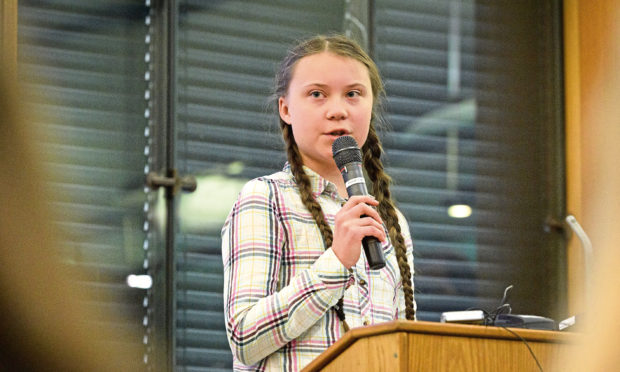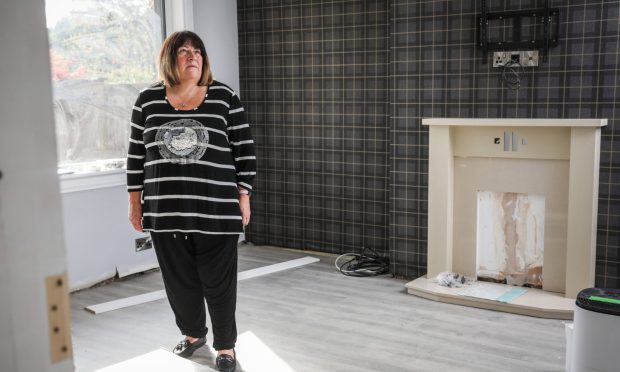Greta Thunberg and the Extinction Rebellion (ER) have their critics, but the evidence is clearly on their side. The broadcast media collectively reported the ER protests as “middle-class people disrupt traffic shock” – a lazy cop-out from the real story.
It’s a global tale of doing too little too late.
Greta ducked school to protest outside the Swedish parliament at the lack of action on climate change.
She has been copied by schoolchildren across the world.
This makes her an ideal photo-opportunity for politicians, and Westminster leaders were eager to be snapped next to her this week in London.
The SNP’s Iain Blackford used the moment to brag: “The Scottish Government’s Climate Change Bill has been hailed as ‘a concrete application of the Paris Agreement’ by Laurent Fabius, the architect of the Paris Agreement.
“The bill contains the most ambitious statutory targets of any country in the world for 2020, 2030 and 2040, with the aim of Scotland being carbon neutral by 2050,” she said.
Another architect of the Paris agreement and chief executive of the European Climate Foundation, Laurence Tubiana, has praised the British Government.
“This decision to review Britain’s long-term climate target sends a strong message to the EU and other big economies that London is committed to the Paris Agreement, and now it’s time they too considered what more they can do.”
Britain sounds like it’s doing the right thing. If only it were enough.
The International Panel on Climate Change (IPCC) special report of 2018 is the benchmark for climate policy, and it reports the world has a decade to restrict global temperature rises.
The Scottish Greens report this as “The IPCC… findings add up to one clear, over-riding message that confronts humanity with the most important decision it will ever make: act now and deliver massive emission reductions over the next decade or face climate breakdown.”
The IPCC is saying that the game got a lot bigger and we need to do a lot more.
Carbon neutral by 2050 does not cut it. The governments of Edinburgh and London are building a dinghy – what’s needed is an ark.
The Greens say the “…Climate Bill… going through the Scottish Parliament now…(is) not strong enough and it doesn’t respond to the latest science coming from the Intergovernmental Panel on Climate Change.”
They propose a Climate Emergency Bill which has a 10-point plan:
1. Lead a green energy transition. Scotland is on track to generate 100% of our electricity needs from renewables in the next five years. This is great progress but we need to see similar gains made in generating the energy we use for heating our homes from renewables rather than fossil fuels.
2. Divest all public investment from the fossil fuel industry, including public bodies’ pension funds.
3. Increase funding for walking and cycling, putting Scotland on par with the Netherlands.
4. Better buses and reliable rail that are publicly funded and cheap to use.
5. Develop a district heating funding stream to deliver renewable heat to homes across Scotland.
6. Deliver warm homes for all, ending the scourge of fuel poverty and ensuring all homes achieve at least an EPC Band C rating by 2030.
7. Support climate-friendly farming and land management, including a massive increase in investment in sustainable forestry and peat restoration. Introduce a nitrogen budget for the farming sector to reduce harmful nitrous oxide emissions.
8. Tax single-use plastics. For example, Scotland consumes between 200 and 800 million single-use cups each year. A 25p levy or tax would result in an annual revenue of £50-200 million and a significant reduction in consumption.
9. Give councils the power to introduce workplace parking levies.
10. Redirect government business support towards environmentally responsible companies.
All of the above is necessary, but it does not go far enough.
Aviation produces 600 million tonnes of co2, according to Friends of Earth, amounting to “about 3.5% of global warming from all human activities”.
Yet no mention of restricting flights to a personal limit of, say, two a year.
And no mention of the tablets, mobiles and social media.
In 2016, data centres which make the internet possible consumed more electricity (over 400 terawatt hours) than the whole of the UK (about 300 terawatt hours) globally.
A US study warns that 20% of all the world energy could be needed for data by 2025.
To put this into context, the world’s largest data centre is in Virginia, USA, and according the Guardian just 1% of its energy comes from renewable sources.
That is overtaken by the threat from meat production.
A research paper published in Nature magazine in 2018 concluded: “UK and US citizens need to cut beef by 90% and milk by 60% while increasing beans and pulses between four and six times”.
We need an emergency climate bill, but one written with the conviction of a 16-year old girl.
Greta Thunberg told Westminster: “You don’t listen to the science because you are only interested in solutions that will enable you to carry on like before.”
It is equally applicable to Holyrood.









